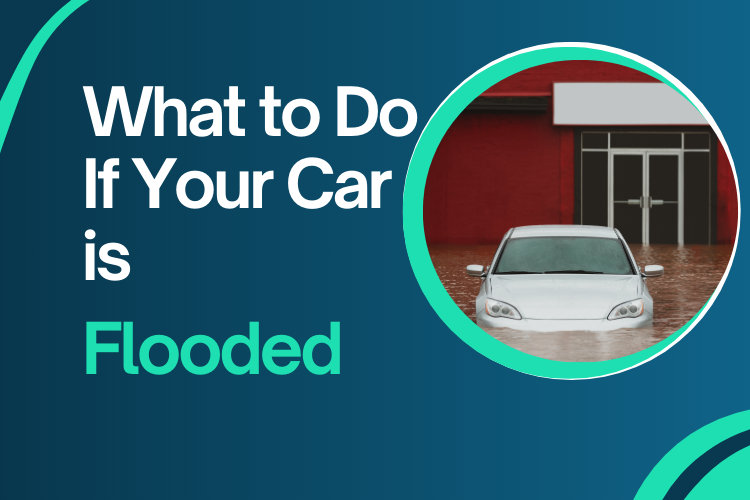The aftermath of a flood can feel overwhelming. Do you start the car? Call a mechanic? Is it even worth saving? The good news: acting quickly and correctly can make all the difference. This guide walks you through the crucial steps to protect your vehicle, minimize damage, and figure out your next move—especially if professional vehicle transport becomes necessary.
Key Highlights
- Ensure Safety First: Don’t start the car and immediately disconnect the battery to prevent engine damage and electrical hazards.
- Assess and Minimize Damage: Check how deep the car in flood water reached. Remove interior water quickly to prevent mold, and inspect the fuel, electrical, and fluid systems for contamination or malfunction.
- Plan Next Steps: Based on the damage, decide whether the car is repairable or needs professional towing for inspection or salvage.
In This Guide:
- Understanding the Risks of Flood Damage
- What To Do If Your Car Gets Flooded?
- What to Do If Car Floods?
- Bottom Line
- FAQs About Flood-Damaged Cars
Understanding the Risks of Flood Damage
Passenger vehicles aren’t built to handle submersion in water, and even brief exposure can lead to serious damage. When water seeps past the door sills and enters the cabin, it introduces harmful organisms and substances that cause mold formation in hard-to-reach areas such as upholstery and carpets.
Electrical components—sensors, motors, switches—are at immediate risk, often shorting out instantly. If they don’t, corrosion can set in and cause them to fail over time. Even structural elements like seat tracks and seat belt assemblies are vulnerable to rust. Addressing flood damage quickly is crucial. The longer water lingers in the vehicle, the greater the risk of extensive damage, making repairs or remediation much harder.
Tip: In addition to flooding, winter weather can impact your vehicle’s condition. Check out our guides for proper car winterization and motorcycle storage.
What To Do If Your Car Gets Flooded?
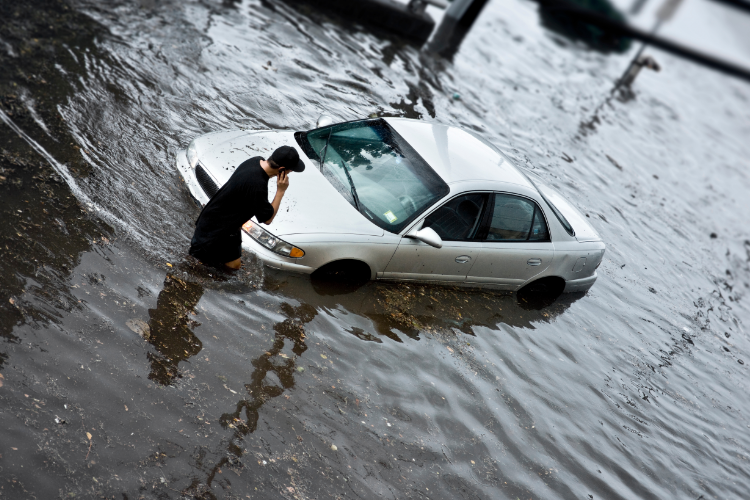
Dealing with a flooded car can be overwhelming; these simple steps will help assess the damage and take necessary action:
Do Not Start the Car
This is key because the first instinct might be to see if the car still runs, but trying to start a flooded car can cause irreversible damage. High water means when the water level rises over the engine compartment.
So, this reflects that the water has been introduced into the intake tract and is likely inside any cylinder with an open intake or exhaust valve. Attempting to start the vehicle at this point will result in a hydro-lock and a damaged engine, which otherwise may be repairable. Water can enter the engine, transmission, and other key systems, potentially destroying the car if you try to turn it on.
Disconnect the Battery
Before doing anything else, disconnect the car’s battery to prevent any electrical issues. Many electrical items in your vehicle have “constant power” running to them. Water mixed with electrical current will cause short circuits and failure in these components.
Simply cleaning and drying them can save them, but you can only do that once you have cut off the power supply to reduce the risk of electrical damage. Disconnect the battery as quickly as possible. If you disconnect the battery in anticipation of a flood, that may save you from a lot of damage. Flooding could happen (like a hurricane), which is a good practice.
Roll Down The Windows
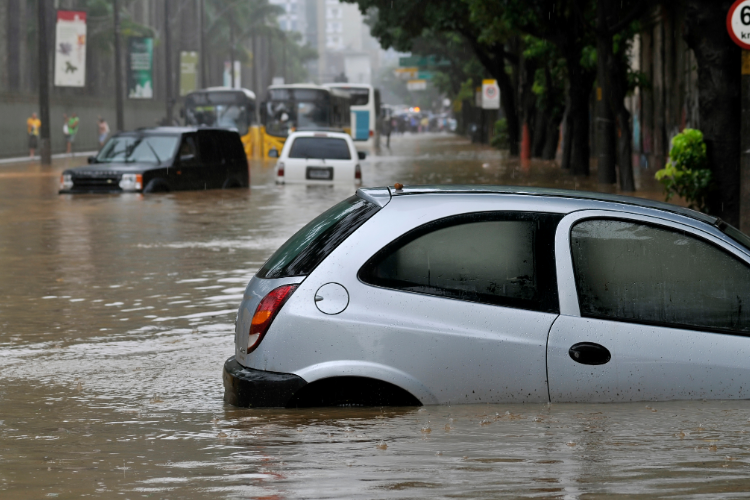
After assessing the car, if you feel it is safe to enter, roll down the windows to help ventilate the vehicle and prevent mold and mildew from developing. This step is key if water has entered the interior. Roll the windows down; if the windows are electric, open the doors.
Look For a High-Water Mark
Inspect your car to determine how deep the water reached. This will give you an idea of the level of damage. It will usually be clear, especially on the interior. This will help assess the extent of the damage and whether your car is salvageable.
The best case scenario is when the watermark is at a low level, below the dash, just on the floorboards. If the water is up over the dash, all the electrical components within the dash and the engine have been compromised. Water lines on the exterior or interior indicate the level of flooding.
Get Any Residual Water Out Of The Car
Start by injecting the residual water into the floorboards with a submersible pump. You can also use a vacuum or towels to remove standing water inside the car. Some vehicles have plastic plugs at the bottom of the doors that can be removed.
Remove these plugs to let water out. If the doors have these, remove the door panels and flush the bottom of the doors out with a hose. Once all the water has been removed, put fans on the vehicle to dry out the interior quickly to prevent mold formation. The faster you get the water out, the better the chances of reducing long-term interior damage.
Drain The Engine / Transmission Oil / Change
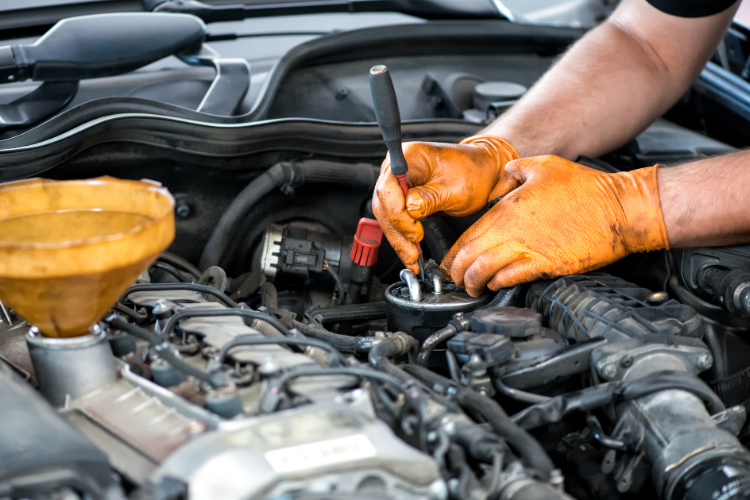
Water can mix with engine oil, causing major issues if left unchecked. Whether or not the water level was lower than the engine, it’s best to drain it completely. Once the system is clean, refill the engine, transmission, and differential fluid, as they may have water in them. Draining and replacing the engine and transmission oil will help protect the systems from corrosion and other water-related damage.
Remove Spark Plugs On High-Water Vehicle
If the vehicle has been in a high-water situation where it is suspected that the engine’s intake tract was compromised, you must remove each spark plug. You can hand-spun or crank the vehicle to check if any water comes from the spark plug holes. It probably did not reach the engine if you do not see water. Remove all the piping from the intake tract and inspect for any mud or dirt indicating floodwater. Rinse the entire intake tract clean.
Check for water in the cylinders by removing the spark plugs BUT before starting the engine. This will prevent hydrostatic lock, which occurs when water enters the cylinders and prevents the pistons from moving.
Check Fuel System
Siphon some gas and check for water at the bottom of the fuel tank since water is heavier than gas. If you spot water mixed in, your tank must be drained and cleaned to prevent damage. Keep your siphon low to get an accurate check! Have a mechanic check the fuel tank, lines, and filters to ensure no water has entered the system. Contaminated fuel can damage the engine.
Check Electrical Systems
Unfortunately, if key electrical systems are below the water line, they will most likely have to be replaced. Although some can be flushed, cleaned, and left to dry, checking and troubleshooting flooded electrical will often be the most labor-intensive of all the checks on the vehicle.
While checking the car’s electrical system, inspect all wiring and electrical components, including lights, fuses, and electronics, to determine if any repairs or replacements are needed.
What to Do If Car Floods?
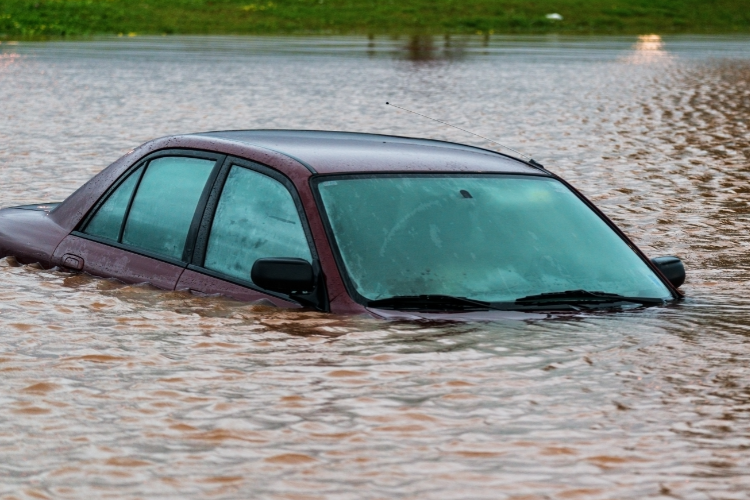
Once you’ve assessed the damage, the next step is to decide what to do with your flooded car. Here are some options:
If the Car Starts
- If your car starts successfully after following the steps above, it’s still important to get it inspected by a professional. Flood damages can be hidden in numerous ways, and may surface later on.
If the Car Doesn’t Start
- If your car won’t start or has suffered severe damage, you may need to consider selling it as-is or sell salvaging parts. In this case, you will require vehicle transport services. Sherpa Auto Transport is a reliable vehicle transport service that will transport your inoperable vehicle to a mechanic or salvage yard. We make sure you have a hassle-free experience. Our extensive network of carriers has the equipment and the expertise to move vehicles anywhere in the country, even if they’re inoperable.
Bottom Line
Water damage can do more than ruin your car; it can derail your day, week, or even your move. But acting quickly and knowing what to do can help you recover faster and reduce the impact. If your car is inoperable or needs to be inspected by a specialist far from where it sits, that’s where Sherpa Auto Transport comes in. Whether you need help with long-distance car transport, wondering if towing your car is safe after a flood, or deciding whether to drive or ship a car, Sherpa has your back.
We work with carriers experienced in handling all types of vehicles even those that won’t start offering peace of mind when you need it most. No matter where you are or where your car needs to go, Sherpa helps you move forward. Contact Sherpa Auto Transport today and let us help you safely get your car to where it needs to be.
FAQs About Flood-Damaged Cars
Can a flooded car be fixed?
A flooded car can be repaired but it depends on the extent of the flooding and how quickly remedial actions were taken. Some of the key tips that may help include removing any water from the car instantly and not starting the engine. Always have a professional mechanic assess the vehicle for damages.
How long will a flooded car last?
A flooded car can last many years, provided it is inspected thoroughly and properly repaired by a professional. If not treated, it may only last a few months or weeks. While repairing a flooded vehicle will take a lot of work, it can be restored to like-new condition.
Is a car ruined if it goes underwater?
If your car is completely submerged underwater it doesn’t always mean its totaled. It may require extensive repairs and maintenance, but it’s possible that it’s salvageable. Fixing a submerged car will involve:
- Removing the water from the engine.
- Replacing all fluids.
- Replacing all or most of its electrical parts.
Keep an eye for rust and corrosion. It may take a while to surface and may go unnoticed for long periods and cause serious problems later.
Is Saltwater or Freshwater Worse for Cars?
Due to its corrosive nature, saltwater damages cars more than freshwater. It causes quick rust and degrades a car’s metal components, making it harder to recover from flood damage.
Does Insurance Cover Flooded Cars?
In most cases, comprehensive auto insurance will cover flood damage. However, the extent of coverage may depend on your specific policy. It’s important to check with your insurer to understand what’s covered and file a claim as soon as possible.

